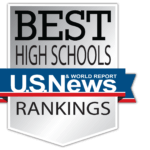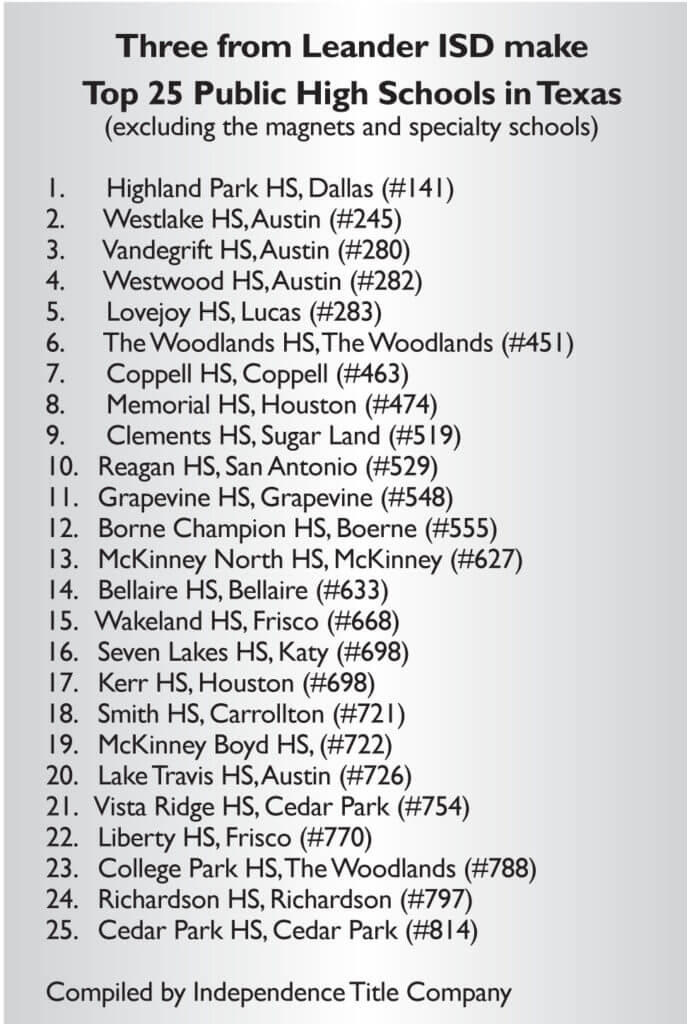By KIM ESTES
Four Points News
Vandegrift High School has been ranked as a science, technology, engineering and math school in U.S. News and World Report Best High Schools rankings, earning the 199th spot after placing as one of the top 500 public high schools in the nation.
Schools had to rank in the top 500 of 22,000 high schools nationwide to be eligible for the STEM ranking. VHS came in at #280 of the total, for which it also earned its 4th gold medal in four years and 47th place among state rankings of 589 Texas high schools. Rankings data was from the 2014-2015 school year.
Two other Leander ISD schools, Vista Ridge High School and Cedar Park High School, were awarded silver medals in the U.S. News rankings report. VRHS was ranked #754 in the nation and 89th in the state. CPHS was #814 in the nation and #99 in the state.
“On behalf of the staff and students, I want to thank you all for this community effort to make Vandegrift the best high school possible,” said Charlie Little, VHS principal.
“I think this is the first time we’ve been ranked as a STEM school; 199 is awesome,” Little said.
 Calling VHS students “amazing,” parents “supportive” and teachers “passionate,” Little also pointed to the Viper Nation Education Foundation and the Leander ISD Educational Excellence Foundation as important to the school’s success.
Calling VHS students “amazing,” parents “supportive” and teachers “passionate,” Little also pointed to the Viper Nation Education Foundation and the Leander ISD Educational Excellence Foundation as important to the school’s success.
VNEF board member Brian Pitman is pleased with the current results.
“This ranking demonstrates that Mr. Little, the Vandegrift staff and the Leander ISD administration have produced one of the very best high schools in Texas,” Pitman said. “We can all be proud of what this staff and our kids have accomplished.”
Both VNEF and LEEF have funded Advanced Placement scholarships to help disadvantaged VHS students take AP exams, which affect eligibility for gold and silver medals as participation rates and scores determine which schools have most successfully prepared students for college.
VNEF gives additional support in other areas, such as preparatory programs.
“VNEF has funded our PSAT team, Junior SAT prep class, College Jump Start program, Academic UIL, Naviance and teacher professional development. Each of these supports has contributed directly to improving our performance on the key college readiness indicators,” said Little. “Over the next few years, we will continue to see the growing impact of these important programs on the success of Vandegrift.”
VHS has been on a path to improvement in national rankings as determined by the U.S. News methodology, moving up from #342 in 2016 and #437 in 2015.
Achieving the STEM ranking is a new benchmark. “It’s a good barometer of how the school is doing,” said Little.
Once a public high school placed in the top 500 of Best High Schools, thereby becoming eligible for the STEM ranking, it was judged on its level of math and science participation and success using AP STEM test data. The top 250 high schools that achieved a value of greater than or equal to 67.5 in their STEM Achievement Index scored high enough to be numerically ranked. VHS achieved a STEM index of 71.8.
As to state rankings, VHS advanced this year from #54 in 2016. In 2015, it was #52 in the state. A school’s national position determines its state ranking. Even if the highest-ranked high school in a state is #60 nationally, it is still ranked 1st in its state, and so on down the line.
VHS’ state ranking further improves when charter and specialty schools, which admit students through an application process, are removed from the list. In that case, VHS is the third-highest ranked school in the state, behind #1 ranked Highland Park High School in Dallas and #2 ranked Westlake High School in Austin.
“When being compared to charter schools, which are essentially private schools, it’s important to note that we take everyone who walks through the door,” said Little.
Ranking methodology
U.S. News has reported that the core principle of its methodology for identifying the Best High Schools is that “the best schools must serve all students well and must produce measurable academic outcomes that support this mission.”
U.S. News teams with RTI International, a global nonprofit social science research firm from North Carolina, to implement the methodology. It used a four-step process to generate rankings:
• Step 1: Identify high schools that performed better than expected on state accountability assessments, given their population of economically disadvantaged students, or were in the top 10 percent of the state’s distribution of performance.
• Step 2: Identify high schools whose disadvantaged students performed better than the state average of disadvantaged students.
• Step 3: Identify high schools that met a basic criterion for graduation rates.
• Step 4: Identify high schools that performed best in providing students with access to challenging college-level coursework.



